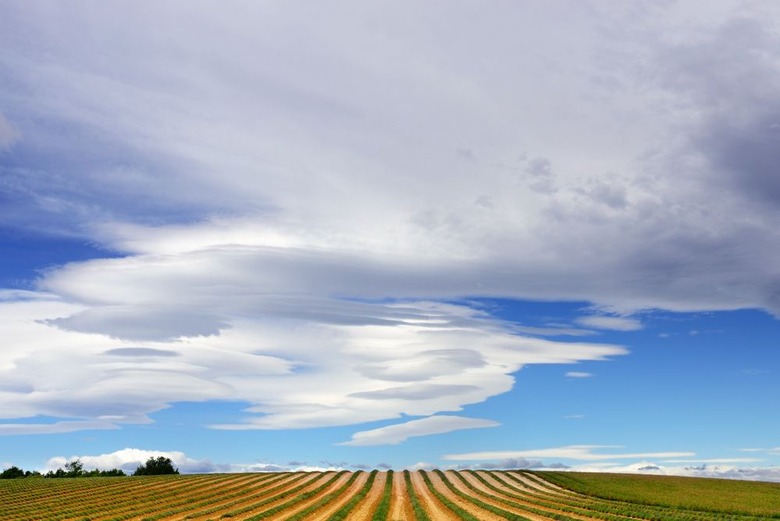How The Wines Of The Southern Rhône Are Shaped By A Mighty Wind
The mistral is a wind that blows from northern and northwestern France to the southeast, traversing the Rhône valley on its way to the Mediterranean. It is caused by high pressure in the Bay of Biscay offset by low pressure in the Gulf of Genoa, conditions that are most common in the winter and spring. By the time the wind reaches the southern Rhône, it commonly exceeds 50 mph, and often blows for days in a row. There are stories of people in the region becoming depressed by its relentless force. Farm houses in Provence are built with a windowless wall facing north to defend against it. Vines grow bent permanently to the south in response to it, which doesn't affect the flavor of the wine made from these vines' grapes but does attest to the mistral's force.
How does the mistral affect the wine made in the southern Rhône? On a recent media visit to the region, I asked two winemakers that question.
Rodolphe de Pins, owner/winemaker of Château de Montfaucon, near Châteauneuf-du-Pape, put it thus: "It's a real help to fight disease. During vintage, after a rain, it dries out the grapes but also helps to dry the soil so it allows the vigneron to go back in the vineyard earlier and sometimes save the harvest." Because of its dehumidifying effects, he continued, "It can stop or reduce any development of fungus, botrytis, mildew, etc., so in general it helps reduce the number of sprayings required for any kind of viticulture — conventional, organic, biodynamic. It makes it easier to grow organic."
How different would the viticultural landscape look without the wind? De Pins again: "In general, without the mistral, our region would certainly be much more humid, due to Mediterranean influence and the Rhône itself." He added that agronomists have said that, without the mistral, the region would look more like the swampy countryside of the nearby Camargue.
Nick Thompson, proprietor and winemaker at Domaine de L'Ameillaud in Cairanne, agreed: "One could simply extrapolate that without the mistral there would be a higher exposition to disease." Without the wind, he said, "Everything turns upside down. There would be a brutal change in the climate and since climate has a critical impact on the choice and growth of grapevines, we [would] have a big problem. There are not that many varieties of vines that support the Mediterranean climate. Who knows what would happen if there was no wind? I guess that we would have either no vineyards or at least something completely different."
Not all the effects of the mistral are beneficial to grape growers, however. "It also has a huge influence on temperature, in all seasons," said de Pins. It can lower it by 10 degrees or more. "For example," he said, "a normal summer temperature here of 32 degrees Celsius [90 degrees Fahrenheit] without the mistral can be 25 C or 26 C [77 F or 79 F] with the mistral. In winter, the effect is even worse, 5 C [41 F] without the mistral is fine, but the same day with a 100 kph [62 mph] mistral will accentuate the cold feeling by five to ten degrees. Just as a story, my wife, who is Finnish, says she had never had felt so cold before coming here."
Another difference observed by de Pins: "During flowering, the mistral can be responsible for many flowers dropping, which will have an effect on the quantity. Too much flower dropping can be dramatic, but in general it works well for quality when it is not over 30 percent [of the fruit]. It helps the vines to have more intense fruit and flavor." The mistral, then, can have "a positive influence if you are looking for quality or a negative one if you look for quantity."
Also, he said, "In the spring, when the shoots are very tender, if the mistral blows very strongly it can break many of them, causing a loss of production but also modifying the structure of the plants, which will make them more complicated to prune the next winter."
Nick Thompson notes the wind's effect on small shoots: "The ideal is to have some windy days when the shoots are small. They seem to anchor in better to the trunks. The damage is done when the shoots are 20 to 30 cm [about 8 to 12 inches] long and have seen no or little wind. Since the wind blows in gusts, this causes breakage." He adds: "What vines do not like in particular is radical changes in the ambient temperature at flowering time. Too warm [a temperature] seems to lower fertility, and too cold also. It is the sudden variation that is the problem, particularly on grenache. In late May or early June a strong mistral could certainly upset things, but also its absence."
One other effect of the mistral noted in the literature is that it extends so high in the atmosphere that it tends to clear the sky of clouds. This increases the number of hours of sun each year.
I wonder if the absence of the mistral would allow the growing of taller vine trellises. That would change the choice of grape varieties, canopy management, and yields.
On balance, de Pins says of the mistral: "It has positive and negative influence. Overall? I think way more positive — especially on the final quality of the wines."
